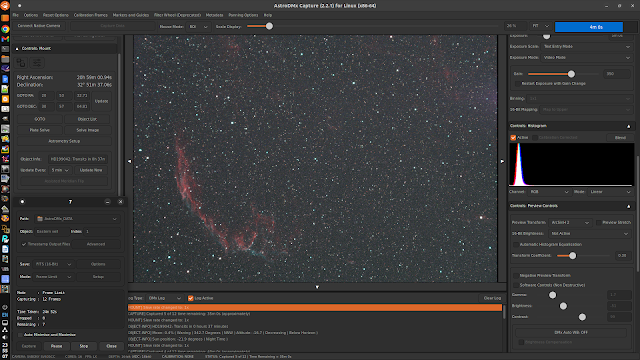Equipment used
Click on an image to get a closer view
The equipment comprised a Stella Mira 66 ED APO refractor with a field flattener, an Altair magnetic 2" filter holder with an Altair Quadband filter; a ZWO EAF and a SV405CC OSC 14 bit TEC cooled CMOS camera, using an SVBONY SV165 guide scope with a QHY-5II-M guide camera. The equipment was mounted on a Celestron AVX mount.
Black felt cover for the filter holder
Moving the cover away allows for filter changing.
Black felt cover over the filter holder
The cover prevents stray light from any source from entering the mainly light-tight filter holder as extra protection.
Imaging computer indoors running Ubuntu Cinnamon Linux
The work involved collecting data on three different nights and in some cases combining the images into mosaics even though there had been some camera rotation between sessions.
As usual, the mount was placed on marks on the ground which gives a good polar alignment when care is taken with the placement of the tripod feet.
PHD2 was used for multi-star pulse auto-guiding and was controlled by a separate Linux computer indoors.
Screenshot of the PHD2 auto-guiding computer
AstroDMx Capture captured the data, controlled the mount and the ZWO EAF via an INDI server running on the imaging computer indoors.
AstroDMx Capture was used to send the scope/mount to Altair; with plate-solving to centre the star. AstroDMx Capture then controlled the ZWO EAF via the INDI server to exactly focus the star using a Bahtinov mask.
In the previous blog article we described the capture of data on the Western Veil nebula and Pickering’s Triangle. Here we collect data on the Eastern Veil nebula by centering the image on the star HD 199042. The reason for using ths star was to frame the image to combine with the Western Veil and Pickering’s triangle as a mosaic. It would not have produced the required mosaic if we had simply centred on the offcial coordinates of the Eastern Veil nebula. The official coordinates of many deep sky objects are in what often seem to be illogical locations. For this reason we frequently use a star around which to frame a deep sky object.
AstroDMx Capture was used to send the scope/mount to the star HD 199042, automatically, repeatedly plate solve and move until an accuracy of 5 arc-seconds was achieved, placing the Eastern Veil nebula in the required position in the field of view.
Screenshot of AstroDMx Capture capturing 1 hour’s worth of 5 minute exposures of the Eastern Veil, nebula
Darks. Flats and dark flats were also captured.
With a negative preview
The data were calibrated and stacked in Deep Sky Stacker and post processed in the Gimp 2.10, Starnet++ Gimp plugin Siril and Neat Image.
The Eastern Veil nebula
Microsoft ICE was used to combine the Eastern Veil nebula and the Western Veil nebula from the previous blog post into a single mosaic image. Then any residual gradients were removed with GraXpert.
The Eastern and Western Veil nebulae and Pickering’s Triangle mosaic image
AstroDMx Capture was used to send the scope/mount to the star HD189777 within Sharpless 101, the Tulip nebula.
Screenshot of AstroDMx Capture capturing 1 hour’s worth of 5 minute exposures of the Tulip nebula
With a negative preview
The data were calibrated and stacked in Deep Sky Stacker and post processed in the Gimp 2.10, Starnet++ Gimp plugin Siril and Neat Image.
Sharpless 101, the Tulip nebula.
AstroDMx Capture was used to send the scope/mount to the star HD 199870 within NGC 7000, the North America nebula.
Screenshot of AstroDMx Capture capturing 1 hour’s worth of 5 minute exposures of the North America nebula
With a negative preview
The data were calibrated and stacked in Deep Sky Stacker and post processed in the Gimp 2.10, Starnet++ Gimp plugin Siril and Neat Image.
NGC 7000, the North America nebula.
AstroDMx Capture was used to send the scope/mount to the star HD 198639 within The Pelican nebula
Screenshot of AstroDMx Capture capturing 1 hour’s worth of 5 minute exposures of the Pelican nebula
With a negative preview
The data were calibrated and stacked in Deep Sky Stacker and post processed in the Gimp 2.10, Starnet++ Gimp plugin Siril and Neat Image.
The Pelican Nebula
Microsoft ICE was used to combine the North America nebula and the Pelican nebula into a single mosaic image. Then any residual gradients were removed with GraXpert.
The North America nebula and the Pelican nebula mosaic image
The SV405CC camera performed well with Version 2.2.1 of AstroDMx Capture and the Stella Mira 66 ED APO refractor with a field flattener, an Altair magnetic 2" filter holder with an Altair Quadband filter.
The new and modified INDI controls in AstroDMx Capture worked without any problems
AstroDMx Capture for all platforms can be downloaded HERE.



















